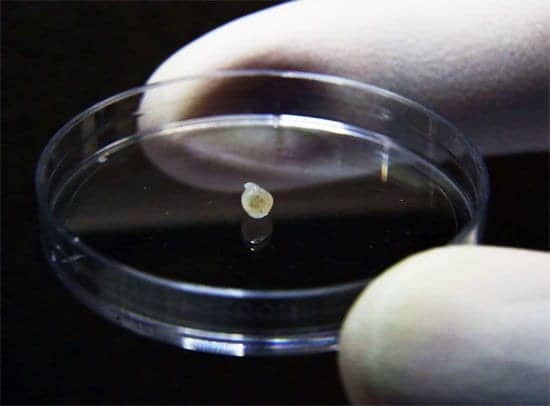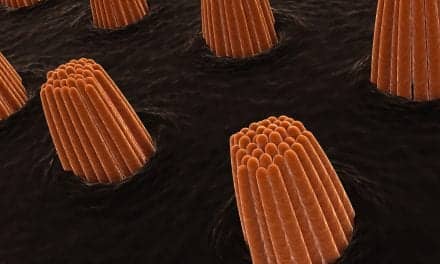
A mini midbrain organoid in a petri dish, containing hallmarks of the human midbrain, which governs auditory and other functions. Photo credit: Image courtesy of The Agency for Science, Technology, and Research (A*STAR)
Singapore scientists have made advances in research on the “mini-brain” – mini versions of the human midbrain. Their creation of the “mini-brain” in the lab is a key breakthrough for research studies of Parkinson’s Disease (PD) and other age-related diseases.
Using stem cells, the scientists have grown pieces of tissue, known as brain organoids, measuring about 2 to 3 mm long. These organoids contain the necessary hallmarks of the human midbrain, including dopaminergic and neuromelanin neurons. According to researchers at the Agency for Science, Technology, and Research (A*STAR), these mini midbrains are three-dimensional miniature tissues that give researchers access to the material that is affected in Parkinson’s Disease. Further, different types of studies can now be conducted in the laboratory instead of through simulations or on animals.
“The human brain is arguably the most complex organ and chronic brain diseases pose considerable challenges to doctors and patients,” said Tan Eng King, PhD, research director and senior consultant, Department of Neurology at NNI and lead investigator of the TCR Programme in Parkinson’s Disease. “This achievement by our Singapore team represents an initial but momentous scientific landmark as we continue to strive for better therapies for our patients.”
The human midbrain is considered “the information superhighway” of the human body, controlling auditory function, vision and eye movements, and body movements. It contains special dopaminergic neurons that produce dopamine, which plays an important role in executive functions, motor control, motivation, reinforcement, and reward. High levels of dopamine elevate motor activity and impulsive behavior, whereas low levels of dopamine lead to slowed reactions and disorders like Parkinson’s, which is characterized by stiffness and difficulties in initiating movements. A dramatic reduction in neuromelanin production also can cause tremors and impaired motor skills.
Jointly led by Ng Huck Hui, PhD, from A*STAR’s Genome Institute of Singapore (GIS) and Shawn Je, PhD, from Duke-NUS Medical School, this collaborative research between GIS, Duke-NUS, and the National Neuroscience Institute (NNI) is funded by the National Medical Research Council’s Translational Clinical Research (TCR) Programme in Parkinson’s disease (PD), and A*STAR. Other collaborators are from the Lieber Institute for Brain Development, the Johns Hopkins University School of Medicine, and the Nanyang Technological University.
“It is remarkable that our midbrain organoids mimic human midbrain development,” said Shawn Je, PhD. “The cells divide, cluster together in layers, and become electrically and chemically active in a three-dimensional environment like our brain. Now we can really test how these mini brains react to existing or newly developed drugs before treating patients, which will be a game changer for drug development.”
“Considering one of the biggest challenges we face in PD research is the lack of accessibility to the human brains, we have achieved a significant step forward,” said GIS Executive Director Ng Huck Hui, PhD. “The midbrain organoids display great potential in replacing animals’ brains, which are currently used in research; we can now use these midbrains in culture instead to advance our understanding and future studies for the disease, and perhaps even other related diseases.”
Source: the Agency for Science, Technology, and Research (A*STAR); the Singapore Ministry of Health’s National Medical Research Council






I disagree. Look at:
http://www.washington.edu/news/2015/09/23/uw-team-links-two-human-brains-for-question-and-answer-experiment/
Best regards, Star